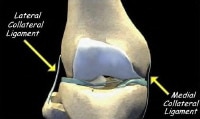Background
Lateral collateral ligament (LCL) injuries result from a varus force across the knee. A contact injury, such as a direct blow to the medial side of the knee, or a noncontact injury, such as a hyperextension stress, may result in a varus force across the knee injuring the LCL. In terms of functionality, the LCL has often been grouped with the popliteofibular ligament and the popliteus tendon as the posterolateral corner (PLC).
See the figure below.
 The medial and lateral collateral ligaments of the knee. Courtesy of Randale Sechrest, MD, CEO, Medical Multimedia Group NextFunctional Anatomy
The medial and lateral collateral ligaments of the knee. Courtesy of Randale Sechrest, MD, CEO, Medical Multimedia Group NextFunctional AnatomyThe LCL is a round ligament that originates close to the lateral epicondyle and inserts onto the fibular head.
PreviousNextSport-Specific BiomechanicsVarus stressThe LCL is the primary restraint to varus stress across the knee.
External tibial rotationThe PLC, which includes the LCL, popliteofibular ligament, and popliteus tendon, is the primary restraint to external rotation stress across the knee.
PreviousProceed to Clinical Presentation , Lateral Collateral Knee Ligament Injury






0 comments:
Post a Comment
Note: Only a member of this blog may post a comment.